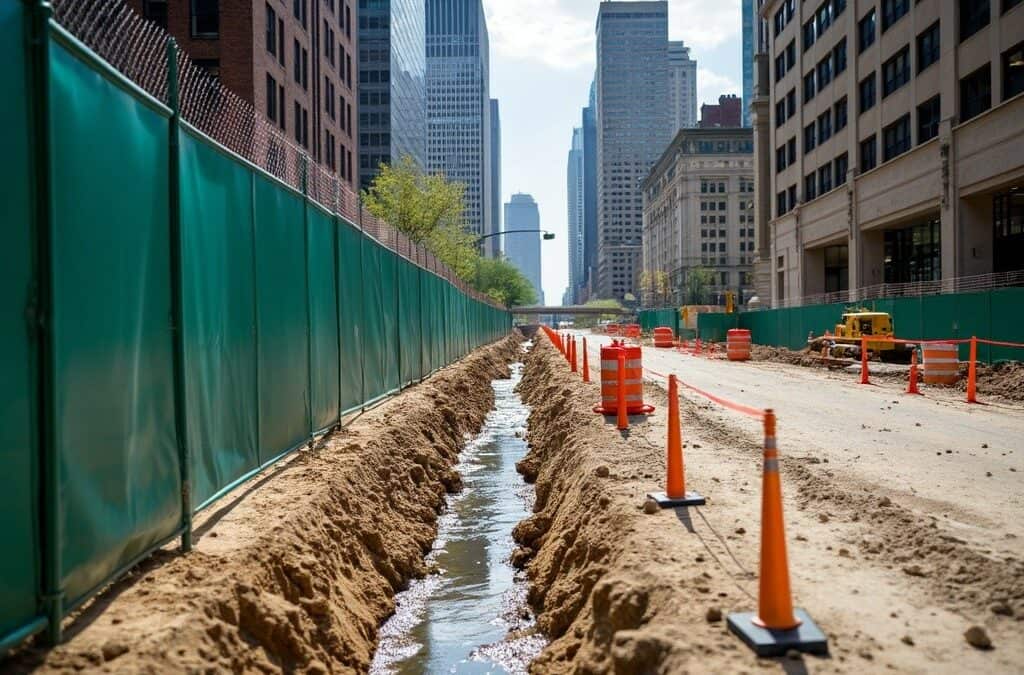When managing a construction project, it’s easy to get caught up in the big-picture details—deadlines, budgets, and logistics.
However, one crucial aspect that often gets overlooked is water drainage and silt fences for sediment control. Without proper planning, runoff from your site can lead to environmental damage, compliance violations, and costly delays.
At Driven Fence, we provide solutions like temporary construction fencing, fence panels, and barricades to help contractors secure their sites. But beyond security, we also recognize the importance of proper sediment control. In this post, we’ll discuss why water drainage and sediment control are essential for construction sites and how tools like silt fences for sediment control logs can help you stay compliant and environmentally conscious.
The Importance of Water Drainage and Sediment Control on Construction Sites
Construction activities disturb soil, leaving it vulnerable to erosion. Without proper silt fence sediment control measures, rainfall or snowmelt can carry loose soil, debris, and pollutants into nearby waterways. This isn’t just bad for the environment—it can also lead to regulatory fines and community backlash.
Here’s why you should prioritize water drainage and silt fences for sediment control:
Environmental Protection
Loose sediment can clog stormwater drains, pollute rivers and lakes, and harm aquatic ecosystems. Implementing best practices ensures your project doesn’t negatively impact the surrounding environment.
Regulatory Compliance
Many states and municipalities, including Illinois, have strict erosion and sediment control requirements for construction sites. Failure to comply can result in hefty fines and project delays.
Site Safety
Poor drainage can lead to flooding, muddy conditions, and unstable ground, creating hazards for workers and equipment.
Reputation Management
Contractors who prioritize sustainable practices and compliance build better relationships with clients and the community.
Best Practices for Water Drainage and Sediment Control
Proper sediment control begins with a solid plan. Here are some best practices to help you keep your construction site compliant and safe:
- Install Silt Fences for Sediment Control
- Use Sediment Control Logs for Drainage Management
- Plan for Proper Water Drainage
- Combine Erosion and Site Security Solutions
While tools like silt fences and sediment control logs are critical for environmental compliance, don’t forget about securing your site. Installing temporary construction fencing or fence panels provides a physical barrier to keep unauthorized personnel out while protecting your erosion control measures from damage. - Monitor and Maintain Your Sediment Control Measures
Winter weather in Chicago can be unpredictable, with heavy rain, snow, and ice all posing challenges to sediment control. Regularly inspect your silt fences, sediment logs, and construction fencing to ensure they remain intact and effective.
Silt fences for sediment control are one of the most effective and widely used tools for controlling runoff. Made of permeable fabric, these fences are installed along the perimeter of a site to trap sediment while allowing water to pass through.
How Silt Fences Help:
Prevent sediment from entering storm drains or nearby waterways.
Reduce the spread of contaminants like oil or chemicals.
Help maintain compliance with local and state regulations.
Pro Tip: Combine silt fences with temporary construction fencing to secure your site and manage runoff simultaneously. This dual-purpose approach keeps your site safe and environmentally friendly.
Sediment control logs (also known as wattles) are cylindrical barriers made from straw, coconut fiber, or synthetic materials. They’re placed on slopes, around drains, or in areas prone to runoff.
Why They’re Effective:
Slow down water flow to minimize erosion.
Capture sediment before it leaves the site.
Easy to install and reposition as needed.
Best Practice: Use sediment control logs in conjunction with fence panels to create a comprehensive strategy for erosion control and site security.
No matter how effective your sediment control measures are, they won’t work without proper drainage. Design your site to manage water flow effectively:
Grade the site to direct water away from sensitive areas.
Use swales, berms, or trenches to channel runoff.
Ensure that water flows toward designated retention or drainage areas.
Why It Works:
Prevents vandalism or accidental disruption of sediment control tools.
Keeps workers and equipment safe by clearly marking boundaries.
Enhances the overall professionalism of your site.
Checklist for Maintenance:
- Replace torn or sagging silt fence fabric.
- Clear accumulated sediment to prevent clogging.
- Reposition sediment control logs after heavy rain or snow.
How Driven Fence Can Help
At Driven Fence, we understand the unique challenges of managing construction sites in Chicago and the surrounding suburbs. While we specialize in temporary construction fencing, fence panels, barricades, and gates, we also support contractors in creating safe silt fences for sediment control, compliant, and environmentally friendly work sites.
Here’s how we can help:
- High-Quality Fencing Solutions: Our fence rental options include everything from chain link fencing to customizable gates, ensuring your site is secure and meets local regulations.
- Expert Advice: Need help planning your site’s layout? Our team can provide recommendations for incorporating sediment control measures alongside your fencing.
- Fast Service: We offer prompt delivery and installation so you can focus on your project.
CTA: Get 10% Off Your Next Fence Rental! - Ready to secure your construction site and protect the environment? Driven Fence is currently offering a New Install Discount—10% off rentals of $1,500 or more! Contact us today to learn more about our fence rental options and get a free quote.
Visit DrivenFence.com to request a quote and take the first step toward a safer, more compliant site.
